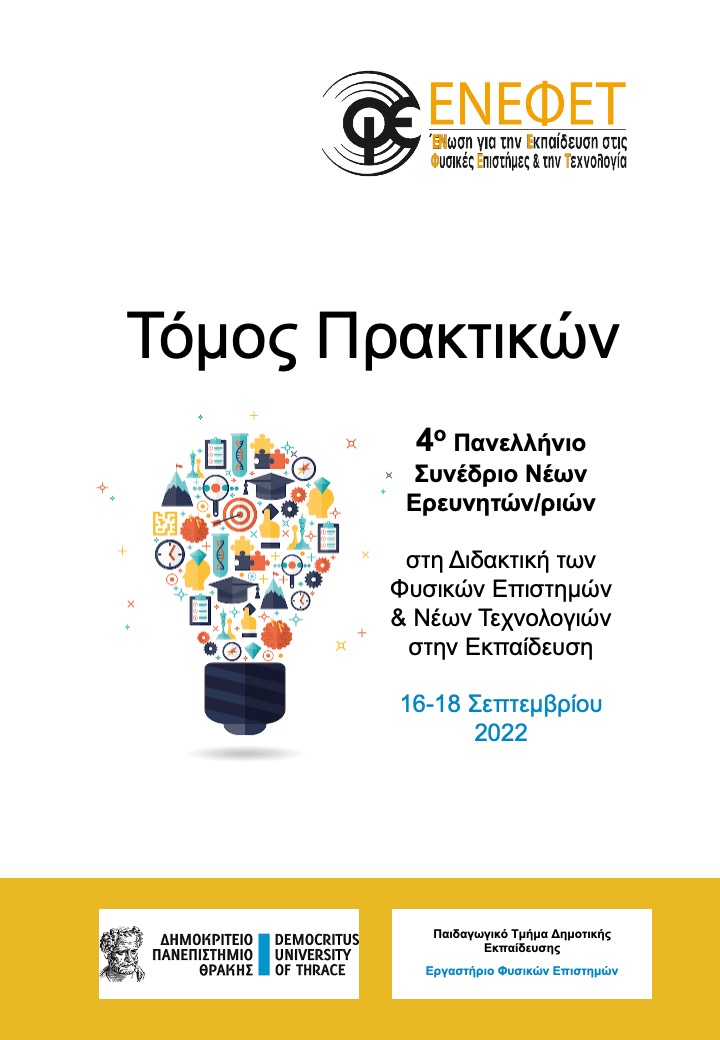Το Ενεργειακό Αποτύπωμα και η διερεύνηση του επιπέδου κατανόησής του από μαθητές/τριες της Δευτεροβάθμιας Εκπαίδευσης. Προσπάθεια για εννοιολογική ανάπτυξη και ενεργό συμμετοχή τους στη μείωσή του μέσω διδακτικής παρέμβασης

Δημοσιευμένα:
Sep 14, 2024
Λέξεις-κλειδιά:
ενεργειακό αποτύπωμα (ΕΑ) ερωτηματολόγιο με εικόνες διδακτική μαθησιακή ακολουθία (ΔΜΑ) μαθητές/τριες Δευτεροβάθμιας Εκπαίδευσης
Περίληψη
Η παρούσα διατριβή έχει ως σκοπό τη διερεύνηση του επιπέδου κατανόησης της έννοιας του ενεργειακού αποτυπώματος (ΕΑ) από μαθητές/τριες της Δευτεροβάθμιας Εκπαίδευσης και την προσπάθεια ενεργού συμμετοχής τους στη μείωσή του, μέσω διδακτικής παρέμβασης. Στην πρώτη έρευνα αναπτύχθηκε ερωτηματολόγιο δώδεκα εικόνων που απεικονίζουν καθημερινά προϊόντα ή υπηρεσίες και συμμετείχαν 416 μαθητές/τριες του πολεοδομικού συγκροτήματος Θεσσαλονίκης. Τα αποτελέσματα δείχνουν ότι οι μαθητές/τριες δεν κατανοούν την έννοια του ΕΑ. Στη δεύτερη έρευνα σχεδιάστηκε και υλοποιήθηκε μία Διδακτική Μαθησιακή Ακολουθία (ΔΜΑ) διάρκειας 20 ωρών, σε 80 μαθητές/τριες Α΄ Γυμνασίου, με σκοπό την αλλαγή των αντιλήψεων και πρακτικών τους προς την αειφορική χρήση ενέργειας.
Λεπτομέρειες άρθρου
- Ενότητα
- Εργασίες Υποψηφίων Διδακτόρων
Αναφορές
Borucke, M., Moore, D., Cranston, G., Gracey, K., Iha, K., Larson, J., & Galli, A. (2013). Accounting for demand and supply of the biosphere’s regenerative capacity: The National Footprint Accounts’ underlying methodology and framework. Ecological Indicators, 24, 518-533.
Collins, A., Galli, A., Patrizi, N. & Pulselli, F.M. (2018). Learning and teaching sustainability: The contribution of Ecological Footprint calculators. Journal of Cleaner Production, 174, 1000-1010.
DeWaters, J. & Powers, S. (2012). Establishing measurement criteria for an energy literacy questionnaire. The Journal of Environmental Education, 44(1), 38-55.
Fang, K., Heijungs, R., & De Snoo, G.R. (2014). Theoretical exploration for the combination of the ecological, energy, carbon, and water footprints: Overview of a footprint family. Ecological Indicators, 36, 508-518.
Galli, A., Kitzes, J., Niccolucci, V., Wackernagel, M., Wada, Y., & Marchettini, N. (2012). Assessing the global environmental consequences of economic growth through the Ecological Footprint: A focus on China and India. Ecological Indicators, 17, 99-107.
Li, X., Tan, H. & Rackes, A. (2015). Carbon footprint analysis of student behavior for a sustainable university campus in China. Journal of Cleaner Production, 106, 97-108.
Li, G. J., Wang, Q, Gu, X. W., Liu, J. X., Ding, Y., & Liang, G. Y. (2008). Application of the componential method for ecological footprint calculation of a Chinese university campus. Ecological Indicators, 8(1), 75-78.
Meheut, M. (2005). Teaching-learning sequences tools for learning and/or research. Research and the Quality of Science Education, 195-207.
Nunes, L. M., Catarino, A., Ribau Teixeira, M., Cuesta E. M. (2013). Framework for the Inter- comparison of Ecological Footprint of Universities. Ecological Indicators, 32, 276-284.
O’Gorman, L., Davis, J. (2013). Ecological Footprinting: Its Potential as a Tool for Change in Preservice Teacher Education. Environmental Education Research, 19(6), 779-791.
Patel, J. (2006). Green sky thinking. Environment Business 122, 32 In Sundha P., & U. Melkania Carbon footprinting: a tool for environmental management. (2016) International Journal of Agriculture Environment and Biotechnology, 9(2), 247-257.
Trappey, A., Trappey, C., Hsiao, C. T., Ou, J. & Chang. C. T. (2011). System dynamics modeling of product carbon footprint life cycles for collaborative green supply chains. International Journal of Computer Intergrated Manufacturing, 25(10), 934-945.





